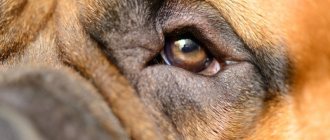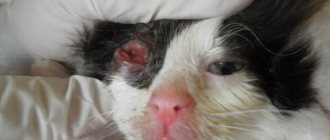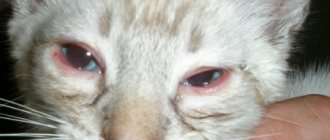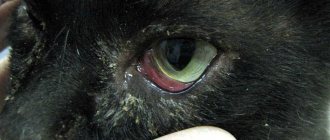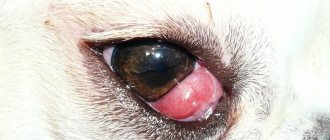When it's ok
If you see brown discharge from your dog's eyes, don't panic. This is normal for many breeds. It is associated with the structural features of the skull and the shape of the muzzle: sagging cheeks, bulging eyes, flat muzzles. These marks are especially noticeable in dogs with light fur. Such problems arise due to improper functioning of the tear ducts. Brown discharge from a dog's eyes has the same origin as discharge from a person's eyes after sleep. They take on a brown color due to exposure to yeast and bacteria.
In any case, the animal must be taken for a preventive appointment with a doctor to make sure that nothing threatens its visual organs. However, brown marks under the eyes are often not a symptom of any disease. This is simply a characteristic feature of this breed.
If your pet has such a problem, every day you need to remove marks under the eyes with a damp, clean cloth. There is no need to use any chemicals as they may get into your eyes. In some cases, the doctor may prescribe special drops to solve this problem.
What causes the area around your eyes to smell?
With most of the problems described above, dogs have simple tears flowing from their eyes. Under the influence of bacteria, rotting occurs, and the hair around the eyes begins to smell unpleasant. If a dog has conjunctivitis, everything gets worse, as a putrid substance leaks from the eyes. You need to regularly wipe the area around the eyes with a cotton swab dipped in lotion, wet wipes and treat the eyes with drops and ointment.
Do not self-medicate. Contact your veterinarian. He will prescribe effective medications and you will quickly rid your pet of unsightly and bad-smelling tracks or circles under the eyes.
Symptoms of the disease
Excessive production of tears in breeds for which this is considered uncharacteristic is the first sign of vision problems in a pet. The eyes begin to leak, wet tracks and dried crusts appear at their corners. White discharge from a dog's eyes indicates serious pathogenic processes in the body.
The dog may begin to scratch its eyes and rub its head against surrounding objects. The eyelids become inflamed and swollen. The whites turn red and the animal’s vision decreases. Problems with orientation in space may begin. If not treated in a timely manner, it is also possible to have an increase in body temperature, refusal to eat, apathy and drowsiness. A pale veil may be visible on the eye, there is more and more discharge from the eye, and an unpleasant odor emanates from it.
Treatment methods depend on the cause of the dog's eye discharge. To accurately diagnose the disease, you must consult a doctor.
Normal eye discharge
Discharge from a dog's eyes is mucous in nature and has a scientific name - epiphora. This is a specific secretion, which is oxidized and thickened tears. The color of epiphora can be grayish, in some cases red-brown.
The color of normal physiological discharge from the eyes of dogs is different from that of humans, which is due to the difference in the composition of the tear secretion. Darkening of the tear secretion upon contact with air is a normal phenomenon and does not require consultation with a specialist.
A large amount of mucous discharge is observed with increased lacrimation or in cases of disruption of the system that removes lacrimal secretions. Any minor damage to the eye area provokes irritation and increased secretion of tears.
Pathological narrowing of the lacrimal opening leads to disruption of the normal outflow of fluid and provokes an increased accumulation of dried crusts of grayish or brown color in the inner corners of the pet’s eyes.
Epiphora is not a dangerous pathology. In order to prevent the development of pathogenic bacterial microflora in the corners of the eyes and eliminate cosmetic defects, it is necessary to regularly clean off accumulated mucus using a cotton pad soaked in chamomile or calendula infusion.
The continuous production of tears in dogs, up to the formation of constant weeping tracks from the inner corners of the eyes, may indicate the presence of neoplasms in the area of the visual organ. This phenomenon should not be ignored. The best option would be to contact a veterinarian for help.
Blocked normal release of lacrimal secretion from the canal in puppies, especially in the morning, may indicate a genetic developmental abnormality - lacrimal punctal atresia. The pathology is rarely diagnosed and only in certain breeds of dogs.
Among the reasons for the development of increased secretion of mucous secretion from the eyes in dogs are: entropion or eversion of the lower eyelid, narrowing of the lacrimal canaliculi, inflammation of the lacrimal sac (dacrocystitis).
Infections
Sometimes, discharge from the eyes can be a symptom of a viral infection. In this case, any delay could cost the animal its life. Infections that can cause eye infection:
- enteritis;
- adenovirus;
- carnivore plague;
- kennel cough;
- hepatitis.
With a viral infection, the dog may have diarrhea and vomiting, the animal refuses to eat, and becomes apathetic. In this case, the pet’s condition deteriorates rapidly. The dog must be taken to the vet immediately, otherwise the animal may die.
Viruses can also affect the condition of the visual organs. Green discharge from a dog's eyes is often accompanied by salmonella. Animals that come into close contact with livestock are at risk. Salmonella is accompanied by elevated body temperature, vomiting blood, diarrhea, and apathetic state. In this case, only a doctor can help.
Mechanical damage
A small scratch or grain of dust is enough to cause damage to the mucous membrane of the eye. While walking, stones, dust, branches, grass and even thorns can get into your dog's eyes. Usually in this case, discharge is observed only from one eye. Due to infection in the wound, suppuration occurs, and white discharge is observed from the dog’s eye. More often, it is thanks to tears that the eye itself is cleared of foreign objects. But if suppuration begins, the dog definitely needs human help. Discharge from a dog's eyes can occur due to a head injury. They also often happen after the dog has swam in a pond. The cause may be sand and algae floating in the water.
Purulent discharge from the eyes of a dog is possible when the upper or lower eyelid is inverted. In this case, the eyelashes and fur scratch the mucous membrane, which leads to serious damage. As a result, ulcers form on the surface; in more severe cases, the animal may lose an eye.
Common Causes and Treatments for Watery or Discharge Eyes in Dogs
If your dog has watery eyes or a distinct discharge (white, green, yellow, bloody, rusty), there is a chance that it is caused by an allergy or physical irritation, such as dust in the eyes, a foreign body, injury, or a dry cornea. Watery discharge or mucus from one eye is often a sign of a foreign body such as an eyelash, while yellow-green or purulent discharge from the eyes may indicate a serious infection. Always contact your veterinarian to find out the cause of your dog's eye discharge because some problems can lead to blindness or loss of the eye if the problems are not treated promptly.
Allergic reaction
The result of exposure to an allergen on the body can be increased tearing of the eyes. In particularly serious cases, white discharge from the dog's eyes is observed. Anything can be an allergen:
- plant pollen;
- individual feed components;
- household chemicals;
- medicines;
- flea drops and collar;
- dust.
Signs of an allergy may include:
- sneezing and coughing;
- itching and baldness of some areas of the skin;
- discharge from the eyes and nose of the dog;
- swollen lips, nose and paw pads.
If left untreated, bronchial asthma and pulmonary edema are possible. Damage from exposure to an allergen accumulates in the body. Therefore, the reaction to it becomes more severe over time, which can lead to suffocation and death of the animal.
Problems with internal organs
Diseases of the internal organs can cause white discharge from the dog's eyes. Particular attention should be paid to the health of puppies and older dogs, whose immunity is often weakened. To determine the cause, sometimes it is necessary to conduct a full examination of the animal.
Many chronic diseases also cause vision problems during periods of exacerbation. The cause of increased tearing can be benign and malignant formations in the area of the lacrimal glands or in the animal’s brain.
First aid
If you notice discharge from your dog's eyes, you should contact your veterinarian as soon as possible. If this is not possible, the animal must be given first aid.
If a foreign body gets into the eye, it must be carefully removed. You need to take a Furacilin tablet, grind it into dust and dissolve it in water. Afterwards, moisten a clean piece of cloth or cotton pad with this solution. It is necessary to pass the cloth from one edge of the eyelid to the other. You can prepare a decoction of chamomile, calendula or St. John's wort. Pour boiling water over the leaves and leave. The solution must be filtered. You can use it to wash your dog's eye several times. The cotton pad needs to be replaced with a clean one every time. Apply tetracycline ointment to the lower eyelid. You can use eye drops. Afterwards, it is important to ensure that the animal does not scratch or rub its eyes with its paws.
Severity of eye injuries in dogs
If we notice that our dog has blood in his eye, the first thing we should do is remain calm and try to examine him. To do this we must hold her head firmly but gently and, with our hands around the injured eye, we will use both thumbs to separate the eyelids and thus be able to examine the eye from the inside and outside. If a dog's eye is bleeding, we can first rinse it with saline or water, which we will apply directly.
If your dog is very nervous, you should seek help as sudden movements can aggravate the injury. If we see any foreign body, we can try to remove it with gauze, unless it is lodged in the eye, in which case we will have to contact the veterinarian. If we see a wound on the eyelids without disturbing the integrity of the eyeball, we can clean it with serum and observe. If a dog gets hurt while trying to scratch with its paws, we can use an Elizabethan collar to prevent this from happening. If we notice worsening, we should consult our veterinarian if treatment with any drug is necessary.
Due to the proximity of the eyes, do not use the same products as the rest of the body, as they may cause irritation. In serious injuries that may be observed, inflamed eyes, that is, bleeding inside the dog's eye, or disruption of their normal morphology, constitutes an emergency that must be treated immediately by our veterinarian.
Treatment
For effective treatment, it is important to make a correct diagnosis. The veterinarian must perform an external examination of the animal and take all necessary tests. After determining the exact cause, treatment must begin.
If the cause of discharge from the eyes is an injury, the affected area should be treated and the wound should be cleaned. The animal can be given painkillers and anti-inflammatory drugs.
If the cause is an allergy, you need to try to find the allergen that caused such a reaction and isolate the animal from its effects. The dog is given antihistamines. Sometimes an allergic reaction may occur to parasites, then the animal must be treated for them.
For an infection, your doctor may prescribe antibiotics. In this case, the animal is given medications that will support its gastrointestinal tract and liver.
During treatment, the animal must be fed low-calorie, balanced and vitamin-enriched food. The pet should get more rest. You may need to wear a special collar to prevent your dog from scratching his eyes.
Thus, discharge from a dog’s eyes often indicates an illness in the animal. To determine the exact cause of watery or purulent eyes, the animal must be shown to a doctor. Before this, the dog is given first aid: the affected eye is washed and treated. If you ignore this symptom and do not provide timely assistance to the animal, the dog may not only lose its sight, but also die.
